Latest Blogs
Software Development
Ramsha Khan
Nov 26, 2025
Enterprise Application Development: A Complete Guide for Modern Enterprises for 2026
Read More...

Top 10 Free & Premium Drupal 8 Themes For 2017
The very first thing which grabs your attention while navigating any website is its appearance. In this tough, competitive world of technology, your website should look beautiful, functional and easy to use.
Drupal offers lots of themes which ensures the beauty of your website as well as provides you a streamlined experience to your visitors. Drupal themes are available in both free and paid flavors. The themes are real easy to install and can be configured in few simple steps.
Right now, Drupal 8 has fewer themes than Drupal 7. But this doesn’t mean that Drupal 8 themes lack in any way. The wide library of Drupal themes consists a variety of themes for every website type. In this blog, I’m going to share some of the best free Drupal 8 themes to make use of.
E-commerce is no doubt one of the most important areas of any CMS. This excellent Drupal 8 eCommerce theme by Weebpal makes the most of the Drupal’s support for that purpose. Now make your online marketplace more attractive, appealing and functional with the Marketplace D8 theme.
Got any forum or website to run which has an integrated forum? After a detailed thorough search, I came across to this amazing Forum plus Drupal 8 theme (again by Weebpal) especially for forums which really makes your website stand out from the crowd.
Offered by morethanthemes.com, has all the desired features you would like to feature on your news website. Enhance the beauty of your news website by installing this excellent News+ theme of Drupal, an all-in-one responsive theme.
Some renewed universities such as McGill University, University of King’s College, and Queen’s University has chosen Drupal Scholarly theme for creating their websites. So if you want to create an educational website too, don’t go anywhere and choose Drupal Scholarly theme, a powerful combination on theme and CMS.
Onpage Drupal 8 theme is one of the great multipurpose and a responsive theme suitable for all kinds of websites. This theme smoothens the flow and structure of websites and helps a lot to the visitor of your website in locating any specific section of your website.
Get Free Quote and Avail Drupal Development Services.
This free Personal Drupal Blog theme is no doubt a beautiful one and functional too, helping you to give a kick-start to your blogging. This is indeed a beautiful theme with all the desired functionalities in just zero cost.
Zircon Drupal 8 theme is a simple, responsive Drupal 8 theme, suits perfectly for a business or a personal website.
A corporate website never requires for fancy artworks or decorative elements. Corporate websites are simple and display all the relevant information of the organization/company or business and the products/services being offered. Choose this Clean Corporate theme for your Drupal 8 corporate website.
Zymphonies is one of the free, responsive Drupal 8 theme, suitable for all kinds of websites and screen sizes.
Drupal 8 Bootstrap business theme is one of the best business / corporate themes which uses the bootstrap framework to adjust your website automatically on different screen sizes without any extra coding or effort.
Drupal 8 offers a variety of themes which ensures you that your website looks beautiful and offer seamless functionalities to your visitors. I have shared above several free and premium themes which are ideal for your websites and if you think I have missed out any, then do let me know in the comment section below.
Saima Naz
Apr 28, 2017

Best Magento Development Blogs & Tutorial Websites...
Started out as a simple e-commerce software in 2007.but over the years, Magento has become the de-facto standard of the e-commerce industry. Magento is available in three distinct but in independent flavors: Magento Community Edition, Magento Enterprise Edition, and Magento Enterprise Cloud Edition.
Written completely in PHP, due to an important reason for the stability and robustness of this platform. The database supported by Magento are MySQL and MariaDB. The most attractive feature of Magento platform is the customization of almost every feature of the storefront and internal mechanics of the online store.
Being only the PHP expert is not enough to become an effective Magento developer. While working with/on Magento, many professional experts find themselves out of their depth. Magento possesses a complicated structure that requires an expert understanding of PHP, MVC, and OOP to accomplish things for real-world online stores.
The most important way of understanding the structure of Magento and improving the quality of your Magento store is to follow high-value resources. These resources shared down here includes the top-rated developers and blogs that regularly publish tutorials and educational material regarding Magento.
The first and the easiest way is to follow the hashtags such as #magento, #magento2, and #realmagento. Social media brings up the freshest and latest articles/blogs published by the top rated resources. Instead of going through and scrolling down unwanted newsfeeds and timelines, just subscribe yourself to these hashtags on social media platform to get the latest news and tutorials as soon as they are published or released.
Stack Overflow is yet another great resource for Magento developers to learn about the new trends of Magento. The vast and huge volume of information on this platform enables the developers to decipher the solution of their Magento problems by reading and following the specific threads.
The real power of Magento is its community people who contribute to the platform and its various components. Magento has a huge list of dedicated developers who regularly contribute to this platform.
Magento development agencies and web development houses are now regularly publishing and updating people with articles and blogs which mainly focuses on the training of developers for Magento. Many professional experts are now preferring these resources because they are created and maintained by certified Magento developers who describes their points in an easy and understandable manner.
Arpatech publishes high-quality Magento articles on its official blog page to tell you more about the latest updates of Magento.
Magento DevDocs is a one-stop solution for you to get to know all the Magneto related guides and information. If you are in search of a customized Magento store, look towards DevDocs.
Magento Community Forums, the official community for the Magento people. In this forum, you can get access to a wide network of dedicated Magento specialists sharing their tricks, tips, and all the support you may need.
Magento StackExchange is the official Q/A forum for all the Magento users. Whatever question you have in mind or being bugged by, there will be many experts available in this forum to provide you the relevant answers.
Training is necessary, especially if you are a beginner.
Join any Magento training platform start participating in different courses to give a kick-start your career growth now.
Sharing down here the list of resourceful and popular Magento blogs to follow to stay updated about the latest Magento trends.
If you are reading this line, well my friend, it means you have done a good job by reading the entire post. I, believe you surely have some favorites too of yours too. Don’t hide. Tell us in the common section below.
Saima Naz
Apr 25, 2017

7 Things to Consider Before Hiring Developer For Your M...
Magento is one of the most top-choice platforms for any e-commerce website development. It is considered as one of the leading e-commerce solutions for creating features full online stores. The features, modules, extensions, scalability and customization options make Magento an ideal and a suitable platform for building powerful and robust e-commerce store.
But, choosing Magento for your eCommerce site will not take you anywhere, instead, you need to select the right Magento development company or Magento Developer who not only understands your business needs but also must possess enough experience to offer you the best Magento solution. To simplify things, I have listed down here some of the important key things you need to keep in mind before you hire any Magento development company.
Before appointing any Magento development company, do consider and check their previous work experience. Look at their previous projects they have worked on, the technical skills, professional capability and the ability of the Magento developers to execute a Magento project successfully. An experienced company can effectively handle the obstacles, troubles and technical challenges faced in between the development process.
Check the portfolio of the Magento development company you are approaching or deciding to select. By looking at their portfolio, one can get a fair idea about the working style and skills of the company’s developers.
You can also get to know about the projects delivered by the company and their commitment towards work and how much dedicated they are. You can even refer to the testimonials of the clients, helping you decide whether the company is capable of executing and delivering the projects to clients’ satisfaction or not.
You need to do a full research before hiring that whether the company has skilled and talented resources or not. You should choose a Magento Development Company that ensures your Magento project is in the right hands. The company should consist of certified Magento developers with necessary experience.
The developers should be aware of the latest tools of Magento and can work on the latest Magento versions.
Make a proper inquiry about the pricing or packages of the Magento Development Company you have chosen to work with. It is important to have a sound knowledge about the flexibility the Website Development Company will provide in any case of changes required. Also, do ask them whether they will charge for any additional work. The Magento Development Company you choose should give you a proper pricing policy to avoid confusions and misunderstandings.
Quality should be the first priority to you if you want to build a successful Ecommerce Magento store. Check out for companies who are CMMi certified or have ISO 9001 certification. Because they will definitely and surely will deliver high-quality Magento solutions, ensuring you the stability and consistency, and also the efficient processes.
Ensure that the company has a proper communication route with you. From the start of the project till the ending phase, one need to be in constant touch with the Magento development team. The project manager or lead who is managing your Magento store should be capable of understanding your requirements and listens to your suggestions for making improvements.
The company should be using best communication channels for the continuous and uninterrupted flow of information. Don’t forget to check whether the developers have good communication skills especially when you choose to work with an offshore Magento development company.
Developing an SEO-friendly Magento online store has become a necessity to get recognized and mark a presence in the virtual world. The Magento developer or Magento Development Company, whoever you chooses, should know as for how to incorporate SEO techniques to help your Magento site get higher ranks in the search engines.
Post deployment support is an important one, to ensure you the proper functioning of your online Magento store after making it live. Keep note of one thing that your customers won’t get affected because of any technical or functional issue arises on your Magento site.
Post deployment support is important for improving the performance of any Magento site. Choose that Magento Development Company who provides on-going support and ensures you the 24/7 support whenever you need.
Building the Magento online store requires a vast technical expertise from the developers. In this highly competitive tech industry, one can’t afford to make or neglect mistakes which may lead to the failure of the online businesses. So it is necessary that your Magento Development Company or developer has the required experience and skills to deliver your desired results.
Get in touch with our certified Magento developers here to get end-to-end Magento services including Magento extensions development and theme & template design.
Saima Naz
Apr 24, 2017

Top 15 Drupal Modules You Should Have In 2017
Drupal is one of the top CMS because of it’s uniqueness and flexibility. Along with the cores, the large collection of Drupal modules is the backbone of the Drupal system. Take examples of some popular Drupal sites, can you find any of them which don’t use even one extending module? Needless to say, they are mandatory. These modules give you the ability to enhance and advance the Drupal functions, features, and grant you the power to do many incredible tasks with your Drupal site.
If you run a Google search, you’ll find some top Drupal modules and their specific functionalities. Similarly, in this blog, I will tell you Drupal module options. They are among the top favorite choices of Drupal developers.
Let’s get down for the details
Views are undoubtedly the most popular Drupal module and also a vital one. Views Display the content more easily. It provides you the facility to show every field (content, taxonomy, terms, users,…) through any type of display. Such as, you can create and display an image, a list of products, a jCarousel, Slideshow,… on your website with it.
Pathauto allows the user to define a pattern for data, and contents so that the system can create an automatic URL. This is an essential module for a Drupal website with a wide variety new contents.
Administration module is a valuable one for website administrators and developers. With this module, you can navigate to the admin menu easily through the smart menu bar on the top. This no doubt saves time while working on the website development.
The Drupal Date module helps in creating a date field type in the Drupal system. It is very helpful especially when you want to create chronological contents, calendar,…
Create a contact form, an event registration, surveys, applications, with none other than Drupal Webform module.
Drupal media module helps in managing the documents, audio & video files. It is liked by many Drupal developers because Drupal core is harder to handle with files & multimedia.
The Context Drupal module permits displaying different elements, or contents on the site based on conditions. Like, if you want some blocks to show up at the bottom of the homepage, and change them differently on the products page.
Wysiwyg doesn’t work by itself, instead, it is a tool allowing you to add content editors. Which means you can edit and work with the content fairly easily and more conveniently.
As the name sounds, this Drupal module is used to generate slideshow with Views. Creating slideshow has never been easy before this.
For a shopping or an e-commerce site, this is an awesome tool. Lots of Drupal websites use this Ubercart module, as it gives tremendous supported in everything from shopping flow to the shopping cart, from promotion to the payment.
To give easy navigation, this custom breadcrumb module gets your breadcrumb path shown on the site. It can be integrated with Views, Panels, Taxonomy Vocabularies and Terms, Paths.
Drupal Gmap module helps to locate your location on Google map. This module is very useful if you want to show your company’s visual address; a property on a real estate website; a restaurant on a deal site. If don’t like the current display, you can even customize the map according to the purpose.
The Meta Tags Quicks module adds meta tags such as title, descriptions, robots to get your page optimized on the search engine. This is a must-have module for Search Engine Optimization.
Internationalization module is a great extension to the core multilingual Drupal. This allows publishing a multilingual website and translates nearly everything on a Drupal website.
Bean module transform the core Blog into a dynamic entity – node, vocabulary, users,… making it easy for you to add multiple fields for your Blog content. You’ll find this module the most valuable one if you use Blog regularly.
So, this is our complete list, well not totally complete. There are some others modules too out there which I haven’t mentioned. I think the top 15 modules makes a long enough list.
Want to make any recommendation on the list? Feel free to share by leaving a comment below.
Saima Naz
Apr 21, 2017

10 Minimalist but Spicy Web Design Ideas for Beginners ...
Some trends are popular for many reasons. They just work, easy to build, users are accustomed to them, flexible across many platforms and present the whole information in a more appealing and meaningful way.
The term minimalism can be defined as cutting down all the unnecessary elements and just focus on what is more important to display on the screen. Basically, minimalism showcases the real purpose of your website.
Though minimalism seems simple on the screen but requires a lot of time in the production and development practices to create a minimalistic piece.
Let’s go through a list of some nice, clean and minimal web designs that really shines in 2017 and hoping that they will be around for many years to come.
When it comes to creating a brand identity, a minimal brand mark can be incredibly useful. Keep your business logo super simple and the color palette very minimal, make it flexible enough to be used throughout the rest of the branding seamlessly, and helps in creating a consistent and a memorable brand.
This bar branding sign above by Simon McWhinnie is an example of being consistent in your web design.
Following minimalism in no way means that your design has to be any less creative. If you’re not trapped down in complex visuals, you often get a chance to explore and play with clever relationships hidden within your design.
Take a look at the branding done by Interband for Opera Australia, a minimalist design to discover a clever relationship between the words.
Minimalism allows considering the spatial relationship of the design in a way you might not have before. Do consider how your design interacts with other elements on the web page to create a wider design.
Check out these above business cards designed by Trevor Finnegan as how their design interacts with other elements to create a wider design.
Minimalism isn’t about the lack of the illustrative elements, but instead of the careful choice of when and where to use them in your website design. Working on an illustrative element that directly relates to your brand name into a logo can help creating a very visual, and yet very minimal design.
The above example by Frame Creative created a very visual yet minimal design by following the technique of being clever.
Minimalism is about skipping all the unnecessary things and only focusing on the website communication. Display the information neatly and efficiently, no crazy visuals required.
See how Jake Frey displayed the information on his business card (above) neatly and efficiently with no crazy visuals required.
Minimalism is just brilliant for functionality. A clean, clear and uncluttered design can make the navigation like a walk in the park. The minimal design and the clear typographical hierarchy makes the navigation of the contents page quick, easy and functional.
The minimal design and typography done by JamesKape have made the navigation of the contents page quick, easy and functional.
The relationship between visual elements like photographs and typography is important to get just right. A good design is the one in which no element overpowers another with no good reason.
One key trick to follow, the simple photographs should be paired with large, attention-grabbing pull quotes, while the more textured and complicated images should be paired with a small piece of body copy creating a balanced harmony between each page.
White space, aka as ‘negative space’, can sometimes look empty or blank space, but this is not entirely true! If use well, white space can help balance out your design, and help it breathe. The idea of white space results in a classy and minimal design.
When there are less visual elements fighting to be seen, designers will able to be a lot more direct with the message conveyed and the overall communication. This can be useful when doing web designing, with a direct and plain message, helps give the viewer an idea of who you are straight away.
Minimalism is the vital component to your web design as it has the potential to be timeless. The fewer elements your design possess, the less chance it may get to go out of style or trend.

Let’s take a look on Google. The screenshots above are of 10 years ago and today’s homepage of Google.
Despite the small change, the white space, the focus on the content, and the minimalism of the website keep the design relatively timeless.
Minimalism is about the way of thinking about your design. Typographically, limit the use of fonts to create a more connected and less confusing design. In colors term, embrace monochromatic schemes but don’t be limited to them only.
Overall, consider what can be removed, whether color from the palette or image from the composition. See what can be replaced with something more concise. Reduce them and just keep what is necessary.
Saima Naz
Apr 19, 2017

How to Hire the Right PHP Developers
If you asked to describe PHP in one word, it would be ubiquitous. Means it’s everywhere. And so are the PHP people, who develop with it. So how can you find an expert PHP developer among all those who claim to “know” the language? This blog here will give you the answer.
PHP is used in more than 80 percent of the websites and applications as a server side language. It is used in more than 80 percent of all the web projects, and with PHP 7 just around the corner, it is only going to rule the web world.
Finding an average PHP developer is not that much difficult. However, mastering this language requires a lot of time and effort, and if it’s the professional few you’re looking for, you will definitely need to design a flawless interview process.
Writing down interview questions, it’s difficult to maintain a balance: you want to test your candidates’ problem-solving and error-resolving ability, but not torture them with a long list of boring, irrelevant questions and potentially drive them away.
Here are some ways to follow while hiring the right PHP Developers.
While you don’t want to irritate your candidates with a standard interview routine, asking one or two basic questions form them won’t hurt anyone. You need to ensure that the candidate must have a good understanding of PHP and how it’s used in the development process.
Get free quote from professional PHP Development Company about your project.
Some of those specific questions will largely depend on the kind of knowledge and skills your project requires. Write down the list of sample PHP interview questions which will help to evaluate the candidate’s expertise. The list should contain server-side, database, and client-side related topics.
It’s important to know what they did on their past projects. However, the project may seem very impressive, but the part they played in them might not be. Ask them their contributions in the project.
Keep in mind that they could have worked under NDA, so if their answers sound little fuzzy, it doesn’t mean you should drop them from the list of your potential hires immediately.
Developers sometimes need to explain things to other developers and non-developers the same, and making them talk about something they find interesting can tell you a whole lot about how they communicate, which is no less important than their PHP skills.
There are few ways to check their coding style. You can use coding tests available online, but ensure that they are real world coding challenges and not some standard “textbook” problems. And in the alternate, you can take their small trial.
Do remember, it’s not the final code that matters here. You just want to check how your candidate does the task and get the opportunity to review their work before handing them your precious project.
You’ll come across many who claim to be the “experts” of PHP, but that doesn’t necessarily mean they’re a good fit for your project.
So make sure you know very clearly what skill set you would like your PHP programmer to possess, what frameworks you are planning to use, and what exactly the ultimate goal of your project is. Use these as guidelines, and, hopefully, hiring the right PHP developers to build your web application will become a little easier.
Saima Naz
Apr 17, 2017

Some Main Things to Know About the Drupal Website Secur...
Drupal, among all the website building platform, gives the best security to your website. Big brands and business websites like the White House, French Government, New Zealand Government, British Council, and the Embassy of the UAE in Washington are all built with Drupal.
The owners of these big websites trust Drupal and feel safe. There must be good reasons for that! Let’s dive into the details and read out some prominent features that make Drupal secure.
If you are planning to create a Drupal website, or already have one, then you are welcome to read about these Drupal website Security benefits and some tips as how to utilize them in the proper way.
The Drupal own security team includes a team of expert professionals from across the globe. They continuously analyze Drupal core and modules, view security reports, respond to the security issues arises, cooperate with the module maintainers, prepare and release fixes. Anyone can contact them to report for errors or get assistance.
Get Free Quote and Avail Drupal Development Services.
Drupal core and contributed modules are constantly updated to provide the high level of functionality and security for your website. Make sure to run the recommended core and module updates for your Drupal website. Old modules should be removed instantly.
In terms of security for custom code, ensures it is written well and accordingly to the Drupal coding standards.
If your site is running on Drupal 6 or on any previous version, do upgrade them to Drupal 7 or Drupal 8 which are now the only two latest versions supported by the Drupal community and, get regular security updates for better performance.
Drupal offers flexible and convenient options for granting permissions to the website’s users or groups of users. Be very sure who you are granting the access to your website. Pay special attention to the roles that are allowed to run PHP code on your Drupal site. It is a safe idea to remove PHP input filter from your Drupal site.
Good news, in Drupal 8, it is no longer even available.
In Drupal, passwords are encrypted with multiple parameters (length, expiration, complexity etc.). Also, a strong database encryption can be configured, with a variety of options to protect the specific information. Make use of it to get advanced security for your website.
Drupal helps prevent from intrusions by limiting the number of login attempts from the same IP address for a particular period of time. You can also keep track of all these login attempts through the administrative interface.
The purpose of Form API is to clean and validate the data before submitting into the database. It tests the data entered by users to match the specific formats and parameters.
Drupal is the most secure, open CMS platform. Follow these Drupal security guidelines and prevent your Drupal site from cyber attacks.
Saima Naz
Apr 14, 2017

Build ASP.NET Web Pages using Razor Syntax
Microsoft Asp.Net framework is used to develop web applications, dynamic websites, and web services. There are basically 6 frameworks introduced by Asp, which is 1.0, 1.1, 2.0, 3.5, 4.0 and among them, 4.5 is the current and latest version of Asp. Every framework comes with advanced classes, methods, and types so the programmers can produce unique things using the features of these frameworks. Let me guide you through all the basics of Asp.Net before we dive into building an application using Asp.Net
MVC, a software architecture pattern, separates the development of application into three components namely Model, View & Controller. Let me tell you what they are about and what they actually do
Model: Manages the entity definition, data access and business logic of the application
View: Represents the UI, and where the user can see information provided by the model.
Controller: Controls the interaction and communication between Model & View
About C#
C#, an object-oriented programming language, developed by Microsoft as a part of the .Net framework.
About Razor
Released by Microsoft for VS 2010 in January 2011, Razor Asp.Net programming syntax enables the programmers to write C# or Visual Basic code embedded in HTML page and used to create dynamic web pages.
Get free quote from professional Asp.Net Developer about your project.
About Visual Studio
Visual Studio is an IDE (Integrated Development Environment) used to create windows form applications, websites, web applications and web services. It supports a variety of programming languages including C#, C++, Python and Ruby.
Let’s start building Web Application Using Asp.Net
So we now know about these software development technologies, let’s create your first web application.
1- Open Visual Studio 2012, go to “File/New” menu and click on “Project”. A window like below will open
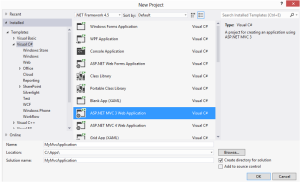
2- In this window, select within the Visual C# options, ASP.NET MVC 3 Web Application.
3- Then in the next window, select the template “Empty”, and “Razor” as View engine, and then click Ok.
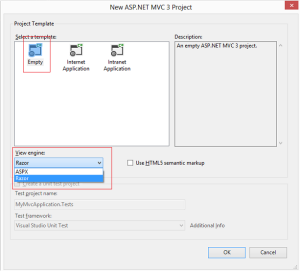
You can now see web application project created with the required folders Models, Views & Controllers also the reference, app data, scripts and other files.
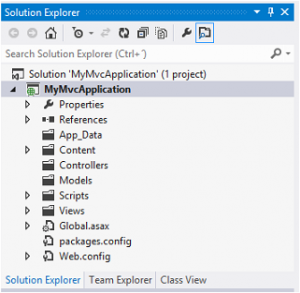
4- Right-click on the folder “Controllers” and “Add/Controller” and you’ll see a window, enter the name of your controller. For e.g. “Index”, and for the template option, leave Empty Controller. Don’t remove the suffix “Controller” in the controller name because it’s showing that this one is a controller class.
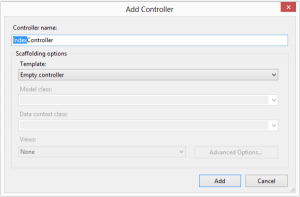
5- Now, right-click on the folder “Models” and select Add/Class. Name this class as you like because this will be the Entity to show in the View. We name it “IndexModel” (the name doesn’t have to include the word “index”). Then, add some properties to the class. For example add ID, Description and Comments properties.
using System;
using System.Collections.Generic;
using System.Linq;
using System.Web;namespace MyMvcApplication.Models
{
public class IndexModel
{
public int ID { get; set; }
public string Description { get; set; }
public string Comments { get; set; }}
}
6– Right-click on the folder “Views” and create a new folder named “Index” (as the controller). Then right-click on that folder and select Add/View. Name the view as “Index” also and as a result, we’ll have a new “Index. cshtml”.
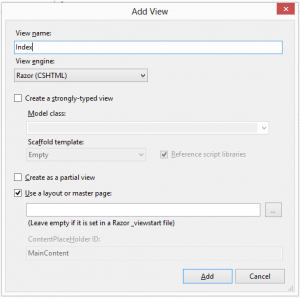
7- Now we have added Model, View, and Controller. Let’s add some code to the controller which will be like this.
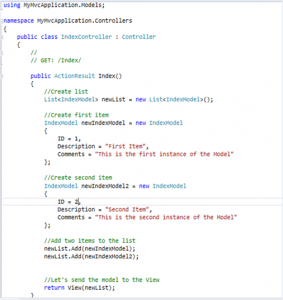
8-Now add some code to the view which will look like this.
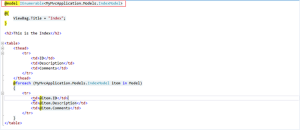
9- Run the Project on any internet browser, and make sure you add to the URL the action “Index”.
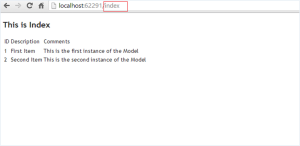
That’s it! You have built the first MVC Application with ASP.NET, using C# and Razor. It’s is the most basic and simple way in order to learn and create your very first web application using Asp.Net with Razor syntax. Hope it helps you in understanding the easiest way to develop Asp.Net Web Application.
Saima Naz
Apr 12, 2017

Top 10 Features in ASP.NET 4.5
ASP.Net, an open source, server-side web application framework, introduced by Microsoft to create dynamic web pages. The framework is designed to help programmers in developing dynamic websites, web applications, and web services.
ASP.Net first version i-e ASP.Net 1.0, was released in January 2002. ASP.Net is built on CLR (Common Language Runtime), let programmers write ASP.Net code with any .net supported languages such as C#, J#, JScript and Visual Basic .net. With ASP.Net you can create more interactive and data-driven web applications. ASP consists a variety of control like text boxes, buttons, and labels for assembling, configuring, and manipulating the code to create HTML pages.
Microsoft ASP.Net 4.5
Microsoft ASP.Net is one of the most successful application development frameworks. The latest and the newest version of this framework is 4.5. ASP.Net is quick to develop and deploy highly scalable and fast performance web applications in a managed environment. Here in this article, I am to going to discuss the top 10 features of ASP.Net 4.5 for the developers.
Get free quote from professional Asp.Net Development Company about your project.
1: Bundling & Minification Feature
The bundling and minification feature in ASP.Net 4.5 will bundle and minimize the size of the scripts and style sheets used in your application. The feature is a great addition in the performance of any web application. The namespace System.Web.Optimization provides the support for bundling and minification of files. When you create a new project in ASP.Net 4.5, these below lines will appear in your Global.aspx file.
protected void Application_Start()
{
//Some code
BundleTable.Bundles.RegisterTemplateBundles();
}
ASP.Net 4.5 have strongly typed data controls. It gives intellisense, just assign the ItemType property to a model which is going to be associated with the data controls used in the aspx pages. Below mentioned code will illustrate how to use Strongly Typed Data Control feature:
<asp:TemplateField HeaderText=”Name” >
<ItemTemplate>
<%# Item.Name.ToString() %>
</ItemTemplate>
</asp:TemplateField>
The below code is a complete markup code of the Grid view control which uses Strong typing:
<asp:GridView ID=”GridView1″ runat=”server” AutoGenerateColumns=”false”
ModelType=”Payroll”>
<Columns>
<asp:TemplateField HeaderText=”FirstName”>
<ItemTemplate>
<asp:Label ID=”lblFirstName” runat=”server” Text='<%# Item.FirstName %>’></asp:Label>
</ItemTemplate>
</asp:TemplateField>
<asp:TemplateField HeaderText=”LastName”>
<ItemTemplate>
<asp:Label ID=”lblLastName” runat=”server” Text='<%# Item.LastName %>’></asp:Label>
</ItemTemplate>
</asp:TemplateField>
</Columns>
</asp:GridView>
ASP.Net 4.5 Model Binding feature allows to develop Web forms which are independent of the model that populates the view. The biggest advantage of ASP.Net 4.5 Model Binding is you can easily unit test the methods. Model Binding in ASP.Net 4.5 is supported through the namespace “System.Web.ModelBinding”. The namespace has value provider classes like ControlAttribute, QueryStringAttribute etc. All these mentioned classes are inherited from the ValueProviderSourceAttribute class.
ASP.Net 4.5 offers many Value Providers which can be used to filter the data. Here are some:
ASP.Net 4.5 gives the support for OpenID for OAuth logins. One can easily use external services to login into the application. Like ASP.Net MVC 4, ASP.Net 4.5 also allows you to register OAuth provider in the App_Start/AuthConfig.cs file. This data dictionary is also can be used to pass additional data.
Paging support in ASP.Net 4.5 GridView control is improved a lot in this version. ASP.Net 4.5 GridView.AllowCustomPaging property gives great support for paging and sorting through the large amounts of data more efficiently.
ASP.Net 4.5 gives excellent support in asynchronous programming. Now you can read and write HTTP requests and responses without the requirement of OS threads. Also, now you have the support of two new keywords await and async.
HTML5 web sockets allows to perform duplex communication between the client browser and the web server. ASP.Net 4.5 offers the support for the web socket protocols. Now you can leverage WebSockets in the ASP.Net web applications.
The namespace which supports the WebSocket is System.Net.WebSocket.
ASP.Net gives excellent support for HTML5 form types. The below following list are the new controls available in HTML5.
ASP.Net Web API is included in ASP.Net MVC 4 and ASP.Net Web Forms. This new feature will help you to build and consume HTTP services easily.
Microsoft ASP.Net is the most successful web technologies till date. It has matured over the past few years and its latest version is ASP.Net 4.5 with amazing new features and advancements.
Saima Naz
Apr 5, 2017